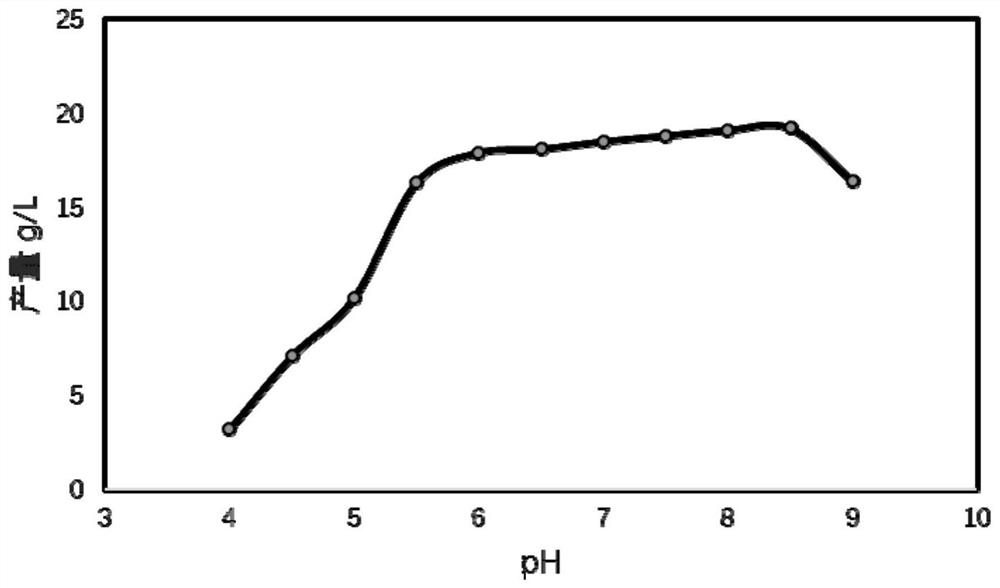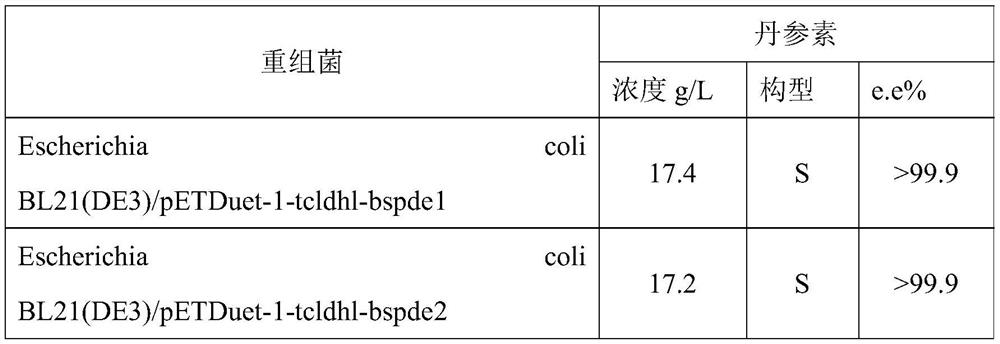A kind of engineering bacteria and method for producing Danshensu
A technology of danshensu and genetically engineered bacteria, applied in the field of bioengineering, can solve the problems of high cost of 3,4-dihydroxyphenylpyruvate intermediate, increase the complexity of catalytic reaction, increase the cost of industrial application, etc., and achieve good industrial application Foreground, simple process, and easy-to-obtain raw materials
- Summary
- Abstract
- Description
- Claims
- Application Information
AI Technical Summary
Problems solved by technology
Method used
Image
Examples
Embodiment 1
[0052] Screening of L-phenylalanine dehydrogenase: According to the random mutation high-throughput screening method of the aforementioned enzymes, error-prone PCR and high-throughput screening platforms were used to obtain three optimal mutants bspde1 and bspde2 for dopa dehydrogenation , bspde3, and sequenced. The amino acid sequences of bspde1, bspde2, and bspde3 are shown in SEQ ID NO:2, SEQ ID NO:4, and SEQ ID NO:6 respectively, and the nucleotide sequences of the genes encoding these three mutants are shown in SEQ ID NO:1 respectively , SEQ ID NO: 3, shown in SEQ ID NO: 5. The specific enzymatic activity of the three mutants of L-phenylalanine dehydrogenase to levodopa dehydrogenation was measured (that is, with levodopa as substrate and NAD as coenzyme, dehydrogenation generates 3,4-dihydroxyphenylpyruvate ) were 20.2, 18.9, 6.4 U / mg, respectively. Taking L-phenylalanine dehydrogenase with the accession NO of the amino acid sequence on NCBI as BAA08816.1 as a control,...
Embodiment 2
[0054] Recombinant Escherichia coli construction: first, the genes encoding α-hydroxycarboxylic acid dehydrogenase and L-phenylalanine dehydrogenase were connected to the plasmid. The double-gene co-expression recombinant plasmid was obtained, the plasmid was transformed into E. coli Escherichia coli BL21 (DE3), and the positive transformant was obtained by screening with an antibiotic plate, that is, the recombinant E. coli was obtained.
[0055]After the induced expression of recombinant Escherichia coli was completed, the bacterial cells were collected, and the final cell concentration was 80g / L in a 100ml reaction system containing 1g / L NAD, 20g / L levodopa, pH 8.0, and reacted at 35°C. The shaker rotates at 50 rpm for 12 hours. After the conversion, the yield and configuration of Danshensu were determined by liquid chromatography.
[0056] The recombinant bacteria in Table 1 were used in the above transformation system, and the results are shown in Table 1.
[0057] The ...
Embodiment 3
[0061] According to the inducible expression method described in Example 1, the cells were collected after the induced expression of Escherichia coli BL21(DE3) / pETDuet-1-csldhd-bspde2 was completed, and in a 100ml reaction system, the final cell concentration was 100g / L, and levodopa 1g / L, pH 9.0, temperature 40°C, shaker speed 50 rpm; transformation time 1 hour. As a result of the measurement, the concentration of S-danshensu was 821mg / L, e.e%>99.9.
PUM
 Login to View More
Login to View More Abstract
Description
Claims
Application Information
 Login to View More
Login to View More - R&D
- Intellectual Property
- Life Sciences
- Materials
- Tech Scout
- Unparalleled Data Quality
- Higher Quality Content
- 60% Fewer Hallucinations
Browse by: Latest US Patents, China's latest patents, Technical Efficacy Thesaurus, Application Domain, Technology Topic, Popular Technical Reports.
© 2025 PatSnap. All rights reserved.Legal|Privacy policy|Modern Slavery Act Transparency Statement|Sitemap|About US| Contact US: help@patsnap.com



